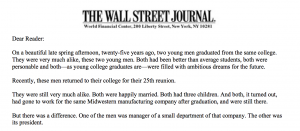 Once again, I’ve seen a reference to The Wall Street Journal’s “Two Young Men” letter by Martin Conroy…
Once again, I’ve seen a reference to The Wall Street Journal’s “Two Young Men” letter by Martin Conroy…
And, as usual, it’s cited as the most successful sales letter of all time.
Which may or may not be true in the absolute sense.
But there’s another seldom-told story that shines light on that letter. And why it may not actually be as powerful of a sales letter as you think it is.
Let’s start with the backstory…
So somewhere around 1974 or 1975, copywriter Martin Conroy sits down to write a subscription letter for The Wall Street Journal.
He turns to his swipe file. In it, he finds an ad for The Alexander Hamilton Institute, written in 1919 by copywriter Bruce Barton, which starts…
“From a certain little town in Massachusetts two men went to the Civil War. Each of them had enjoyed the same educational advantage, and so far as anyone could judge, their prospects for success were equally good. One man accumulated a fortune. The other spent his last years almost entirely dependent upon his children for support.”
(And that, in turn, was lifted from an ad from the previous year, starting “The story of two clerks in New York City who started together a few years ago, side by side, each earning $12 a week.”)
Anyway, apparently Conroy spends a couple hours writing a two-page letter.
The Wall Street Journal mails it, and…
Over the next three decades, it generates more than $2 billion in subscription sales!
And it goes on to inspire generations of young and lazy copywriters to do the same thing Conroy did, and Barton before him — copy the same dang story, with minimal edits, to use as their lead.
Makes sense, after all.
The formula works.
… Or — does it?
I was as convinced as anyone else, until I found myself 46 pages deep into a copywriting book very few copywriters have read — but every one should.
The book is Confessions of a Direct Mail Guy, by Gordon Grossman.
Grossman is one of the OGs — Original Gurus — of direct mail.
Among his many successes, Reader’s Digest would likely have never been anywhere close to what they became if it weren’t for his work on their direct mail. Both in terms of circulation, and the countless other successes they had in complementary publishing.
So I’m reading Grossman’s book, and he drops this bomb…
“What is not mentioned is that the Wall Street Journal had about the least-effective direct mail promotion in the industry…”
He goes on to explain…
They never tested.
Not the copy.
Not the layout.
Not the offer.
Not the envelope.
Nothing.
They “somehow lived with a response rate of about 0.3%.”
He goes on to explain how this was one of the secrets to the staying power of this promotion. Great copy has an impact. It’s memorable. It creates a reaction. And that only happens once.
Alternately, “copy that is virtually unread and almost never acted upon doesn’t wear out very fast. For practical purposes, it almost doesn’t exist in the first place.”
He then explains how his 15%-response-rate Reader’s Digest promotions had them “racing on a highly-profitable treadmill.”
When you’ve just gotten 15% response from a list, you can’t mail it a second time with the same promotion. It is recognized, and discarded without consideration.
The Wall Street Journal had passable economics and a willingness to throw money at a mediocre direct mail piece…
Not only that, they didn’t have a culture of testing.
They had something that worked just well enough that they could keep throwing money at it for year, after year, after year.
And so they did.
Without ever asking, “Could something else work better?”
Do that long enough, and sure, your results add up.
$1 billion, $2 billion…
Great.
I hear Conroy didn’t get a royalty on it. He did earn a spot in history though, for an afternoon swipe job.
But knowing what you know now, how likely are you to swipe Conroy’s work — itself a swipe?
Or would you be better off looking for the next original idea that will generate more than a meager 0.3%?
I can tell you this. Knowing what I know now, there are almost ZERO direct marketing businesses that would be using the Conroy letter a year on, much less a decade.
Because testing is as cheap and easy as it’s ever been.
And the best direct marketers will ALWAYS test your ad against challenger after challenger, until they beat it.
Yours for bigger breakthroughs,
Roy Furr
PS: Here’s a page with the ads reference above and some others that followed the same formula.



